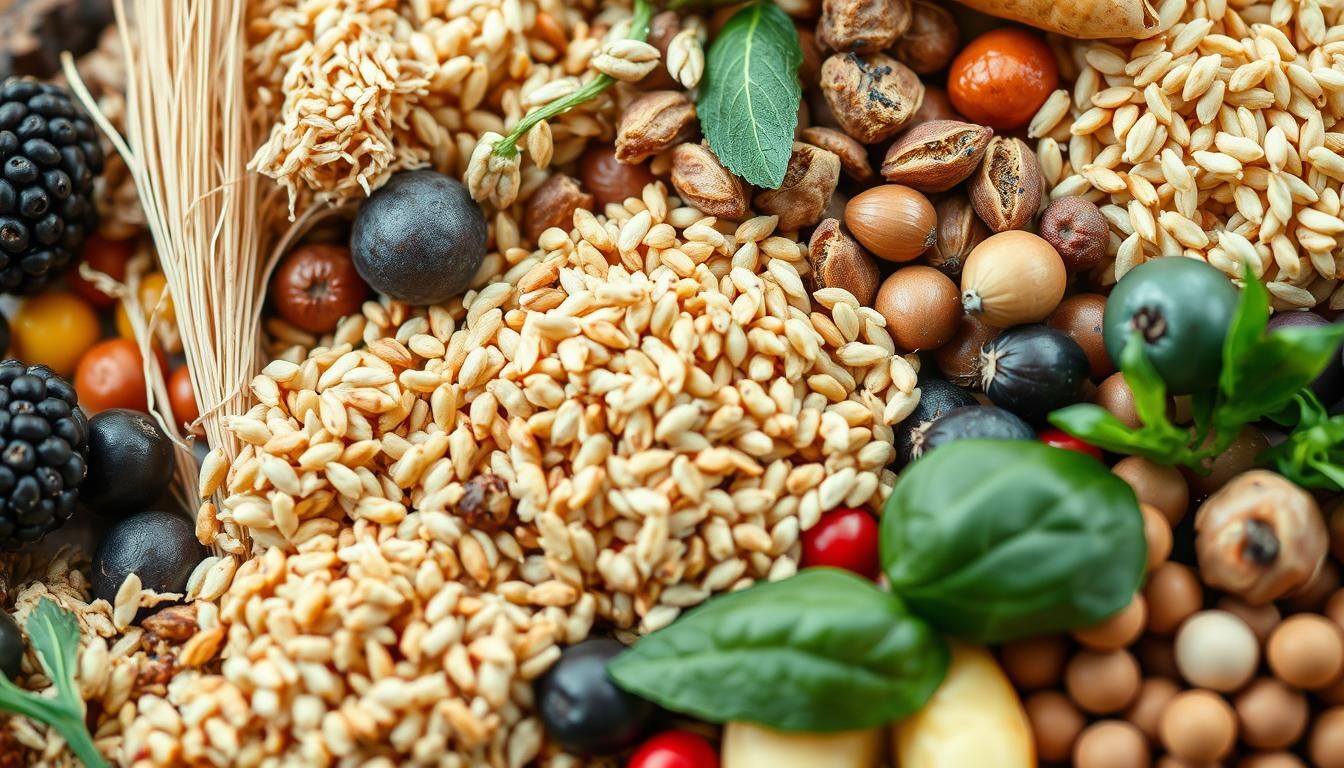I used to dread bloated afternoons and sluggish mornings. When I switched to a simple, plant-forward plan, my energy and mood shifted. That small change made me feel more in control of my body and my day.
This guide introduces fibermaxxing as a friendly, practical approach to digestive health. It explains why only about five percent of adults meet the recommended daily goals and how small swaps can change that. For those exploring comprehensive digestive wellness strategies, fasting and digestive health optimization offers complementary approaches.
We’ll cover how many grams you might aim for, the two main types of fiber, and how to raise your fiber intake slowly to avoid gas or bloating. The idea took off on social media as a useful trend because it helps people enjoy food while gaining real benefits.
Key Takeaways
- Fiber-first shifts are simple, budget-friendly, and sustainable.
- Most adults need to boost their daily fiber and can do so gradually.
- Soluble and insoluble fiber offer different digestive perks.
- Small, consistent boosts at meals add up quickly.
- Supplements can help, but everyday food should come first.
What Is Fibermaxxing and Why It’s Trending on Social Media Right Now
Fibermaxxing is a simple, food-first idea: build meals and snacks around high-fiber foods so you meet or exceed daily targets without a strict diet.
Registered dietitian Sara K. Riehm describes it as aiming for about 25–38 grams of fiber per day for adults. Creators point out that only roughly 5 percent of people get enough fiber, so the approach fills a clear gap.
 The topic blows up on social media and other media because it feels doable. Short videos show fiber-maxed bowls, burgers, and swaps that deliver quick, noticeable benefits like better regularity and lasting fullness.
The topic blows up on social media and other media because it feels doable. Short videos show fiber-maxed bowls, burgers, and swaps that deliver quick, noticeable benefits like better regularity and lasting fullness.
“Make fiber the foundation of a plate, not a restriction,” — Sara K. Riehm
- Problem solved: most adults fall short of daily fiber needs.
- Expert view: dietitians call it safe when you increase fiber slowly and drink water.
- Mindset: treat it as a flexible habit that fits tastes, budgets, and cultural foods.
Fibermaxxing, Defined: Daily Fiber Targets and Types of Dietary Fiber
Aim small and steady: hitting your daily fiber targets is easier than you think.
Recommended daily amounts guide most adults to about 25–38 grams per day — roughly 25 grams for many women and up to 38 grams for many men. Only around 5 percent of adults meet that amount, so focusing on grams helps you set clear goals.
Recommended daily fiber intake in grams for adults
Start by tracking current intake and then add 3–5 grams every few days. This slow ramp-up reduces bloating. Check labels and favor whole-grain swaps to reach your target without dramatic changes.
Soluble fiber vs. insoluble fiber: digestion, blood sugar, and regularity
Soluble fiber dissolves in water to form a gentle gel that slows digestion. This can help lower cholesterol and steady blood sugar levels, giving steadier energy through the day.
Insoluble fiber does not dissolve. It adds bulk and speeds transit, supporting regularity. Combining both types supports digestion across your whole system.

- Food sources: beans, lentils, oats, whole grains, Brussels sprouts, apples, and berries. Explore nutritious whole food approaches for optimal nutrient density.
- Simple tip: swap white bread for whole grain and add a serving of legumes to one meal to boost grams fiber.
- Hydrate as you increase intake to keep digestion comfortable.
For more on how the trend reached the public eye, read this fiber trend coverage.
Evidence-Backed Health Benefits of a Higher-Fiber Diet
Simple shifts toward fiber-rich foods deliver several proven health benefits that matter day to day and long term.

Digestive comfort and regularity
Fiber adds bulk and speeds motility, which helps prevent constipation and keeps the gut moving regularly.
Heart health and cholesterol
Soluble fiber binds cholesterol in the digestive tract, helping to lower cholesterol and support healthier blood lipid levels.
Blood sugar control
Slower digestion smooths carbohydrate absorption, which steadies blood sugar levels and reduces sharp energy dips and cravings.
Weight, microbiome, and risk reduction
High-fiber foods increase fullness per calorie, aiding weight management without extreme dieting.
Fermentable fibers feed beneficial bacteria, producing short-chain fatty acids that support colon health and may lower risk of colorectal disease.
| Benefit | How it works | Common foods |
|---|---|---|
| Regularity | Adds bulk and speeds transit | Whole grains, legumes |
| Lower cholesterol | Soluble fiber binds cholesterol for excretion | Oats, barley, beans |
| Glycemic control | Slows absorption of sugars | Fruits, vegetables, lentils |
Experts stress a food-first pattern: center meals on vegetables, legumes, nuts, whole fruits, and whole grains. That approach delivers broad nutrition benefits and fits current trend demands for easy, effective change.
Is Fibermaxxing Safe? How to Ramp Up Without Bloating
Increasing fiber can help most people, but the way you ramp up matters for comfort and safety.
Set realistic expectations: for many people, adding more fiber is safe. Jumping from very low to very high intake in a single day can cause gas, bloating, or cramps.
Go gradual: add a few grams across several days and note how your gut and body respond. Spread fiber across the day instead of loading one meal.
Who should go slow and when to consult
If you have active GI issues or take medications, the risk of side effects rises. Talk with a dietitian or doctor before big changes so they can tailor the plan to your needs.
Hydration matters
Drink more water when you raise fiber. Without fluids, even healthy food and a higher amount fiber can worsen constipation. Consider natural detoxification methods that support hydration and digestive health.
- Start low and increase gradually.
- Try new foods with familiar staples to ease tolerance.
- If you use a fiber supplement, begin with a small dose and monitor effects before boosting the amount.
Observe and adapt: different foods affect people differently. Keep mental notes about what works best for you and adjust your plan accordingly.
How to Start Fibermaxxing Today: Simple, High-Impact Food Swaps
A few smart ingredient swaps turn familiar meals into high-fiber wins fast. Start small and pick one meal to change each day.
Add beans and legumes
Make beans your baseline: fold lentils into soups and stews, or swap half the ground meat in chili for black beans. You’ll gain extra protein and soluble fiber with minimal effort.
Snack and sprinkle
Power up snacks with a small handful of almonds or sprinkle chia and flax on yogurt. These fiber-rich foods keep you full between meals.
Build your plate
Fill half your plate with colorful vegetables at most meals and choose whole fruits over juices. This boosts dietary fiber, adds vitamins, and slows how fast sugar hits your system.
- Start breakfast with oats or oat-based cereal and top with berries.
- Swap taco meat for black beans or finely chopped walnuts and add avocado.
- Mix shredded carrots or zucchini into burgers and meat sauces for extra fiber and moisture.
- Try whole grains like whole wheat, oat, or teff flour in baking to nudge fiber up while keeping flavor.
Build Fiber-Rich Meals Without Overhauling Your Diet
You don’t need a full diet overhaul to build meals that boost fiber and flavor. Small swaps at breakfast, lunch, and dinner add up to steady fiber intake without heavy restrictions.
Fibermaxx a burger
Use a whole grains bun and a plant-based patty for an instant boost. Top with a heap of crunchy cabbage slaw dressed in vinegar and a smear of avocado for moisture and more fiber.
Tuna rice bowl upgrade
Start with brown rice or another whole grain, add tuna for protein, then layer pickled carrots, cucumber, and avocado. The mix of textures improves digestion and keeps the meal familiar but more nutritious.
Sample day plan to hit 25–38 grams
Breakfast: oats with berries and nuts. Lunch: bean-and-veggie soup plus a side salad. Dinner: the fiber-forward burger. Snacks: fruit and a small handful of almonds. Together these choices can reach your target grams fiber while supporting weight management and steady energy.
- Portion pragmatics: modest changes to sides and toppings elevate daily intake without changing family favorites.
- Keep protein strong: each meal includes a protein anchor for fullness and muscle support.
- Customize freely: swap in seasonal produce or pantry staples to keep the pattern exciting.
For quick, high-fiber recipe ideas to use today, try this collection of 25-minute high-fiber recipes.
Fiber Supplements and Smart Products: When and How to Use Them
A measured supplement can be a practical tool when whole foods don’t reliably close your daily fiber gap.
When a supplement makes sense
Consider a fiber supplement if you often miss fruits, vegetables, and whole grains, or if you have infrequent bowel movements or digestive discomfort.
What to look for on labels
Choose products with psyllium husk or inulin. Check for added sugars and artificial sweeteners. Match soluble fiber choices to goals like supporting heart health and helping to lower cholesterol.
Trend examples and whole-food helpers
- OLIPOP prebiotic soda (~9 g per can) and Gutzy pouches (~8 g) for portable boosts.
- Organic India psyllium blends, Step One nut butter, Maskal teff flour, and pistachios for steady grams and added protein.
How to add supplements safely
Start low, go slow, and drink plenty of water. Track how your gut responds before increasing servings.
Expectations: supplements complement fiber-rich foods, not replace them, and can help support blood sugar and blood lipid levels when used thoughtfully.
Conclusion
A few simple swaps at each meal can close the fiber gap without changing your whole routine.
Fibermaxxing is a food-first, practical way to improve digestive comfort and overall health by centering meals on vegetables, legumes, whole grains, nuts, and fruit.
Make small, steady increases in fiber intake across the day — breakfast, snacks, lunch, and dinner — and hydrate as you go. Simple swaps, high fiber sides, and smart toppings build flavorful meals that support weight and steady sugar control.
This trend took off on social media because it’s doable at home and budget-friendly. If you want guides and ideas, check these fibermaxxing resources.
Try one swap today — oats at breakfast or beans at dinner — and enjoy firmer satiety, steadier energy, and clearer health benefits.
FAQ
What is “fibermaxxing” and why is it trending on social media?
“Fibermaxxing” refers to intentionally increasing dietary fiber to improve digestion, blood sugar control, and overall health. It’s trending because creators share before-and-after results, product hacks, and easy food swaps that make hitting daily fiber targets feel quick and practical.
How much fiber should an adult aim for each day?
Most adults should aim for about 25–38 grams of fiber daily—roughly 25 grams for women and 38 grams for men. Targets vary by age and calorie needs, so consult a registered dietitian if you have specific health concerns.
What’s the difference between soluble and insoluble fiber?
Soluble fiber dissolves in water, forms a gel, and slows digestion; it helps lower cholesterol and steady blood sugar. Insoluble fiber adds bulk and speeds passage through the gut, supporting regularity and preventing constipation. Both types benefit health and should be included in meals.
Can increasing fiber lower cholesterol and improve heart health?
Yes. Soluble fibers like oats, barley, and psyllium bind cholesterol in the gut and help lower LDL cholesterol over time. Along with other healthy habits, higher fiber intake supports cardiovascular risk reduction.
Will more fiber help control blood sugar?
Higher fiber, especially soluble fiber, slows carbohydrate absorption, which helps blunt blood sugar spikes after meals. This can improve overall glycemic control when combined with balanced meals and portion control.
How does fiber affect weight management and the gut microbiome?
Fiber increases fullness, which can reduce calorie intake. Fermentable fibers feed beneficial gut bacteria, producing short-chain fatty acids that support gut health, inflammation control, and metabolic function—factors linked to weight management.
Is it safe to boost fiber quickly, or will I get bloated?
Rapid increases often cause gas, bloating, or cramps. Ramp up fiber gradually over 2–4 weeks and increase water intake to ease discomfort. If symptoms persist, slow the rate of increase or consult a healthcare provider.
Who should consult a doctor or dietitian before increasing fiber?
People with inflammatory bowel disease, recent abdominal surgery, intestinal strictures, or those on certain medications should seek professional advice. Also consult if you have persistent digestive symptoms or complex medical conditions.
How much water should I drink when increasing fiber?
Drink adequate fluids—aim for at least 8 cups (about 2 liters) daily as a baseline and more if you’re increasing fiber. Water helps fiber move through the digestive tract and reduces the risk of constipation or excessive gas.
What simple food swaps give the biggest fiber boost?
Easy swaps include choosing whole fruits over juice, replacing refined bread with whole-grain bread, starting the day with oats, adding beans or lentils to dishes, snacking on nuts and seeds, and using whole grain flours like whole wheat or teff.
Which meals are best for adding fiber without overhauling my diet?
Small changes to favorite meals work well: use a whole-grain bun and slaw on burgers, add shredded veggies to sauces and meatballs, top bowls with avocado and pickled veggies, and mix beans into taco or rice dishes.
Are fiber supplements worth using and when should I consider them?
Supplements can help close a fiber gap if whole-food intake falls short. Consider psyllium, inulin, or methylcellulose if you need consistent soluble or bulk-forming fiber. Choose products without added sugars and start with a low dose, increasing slowly while drinking water.
What should I look for on labels when choosing a fiber supplement?
Check the type and amount of fiber per serving, watch for added sugars, and review other ingredients. Psyllium offers effective soluble fiber; inulin is a prebiotic but can cause gas in some people. Prefer minimal, recognizable ingredients.
Can teens and older adults follow higher-fiber plans the same way as adults?
Teen and older adult needs differ. Teens generally need fiber scaled to calories and growth, while older adults may need gentler increases with attention to hydration and medication interactions. Consult a clinician for tailored guidance.
How can I reach about 25–38 grams of fiber in a sample day?
A sample plan: breakfast with oats + chia, snack of apple and almonds, lunch with a bean salad and whole-grain bread, afternoon yogurt topped with flax and berries, and dinner with a big vegetable stir-fry and brown rice. Combined, these hits typically reach the target range.
Are trendy products like prebiotic sodas and psyllium blends effective?
Some trendy products provide fermentable fiber or psyllium and can complement food sources. Evaluate them for real fiber content, added sugars, and cost. Whole foods remain the best foundation; trends can be occasional additions.
Can I get too much fiber, and what are the risks?
Excessive fiber—especially when increased suddenly—can cause bloating, gas, nutrient interference, and even bowel obstruction in rare cases. Balance intake, spread fiber across meals, and consult a provider if you have ongoing symptoms.
How do beans, nuts, seeds, and whole grains compare as fiber sources?
Beans and legumes offer high fiber and protein. Nuts and seeds add fiber plus healthy fats. Whole grains provide bulk and often more insoluble fiber for regularity. A mix of these sources gives a balanced fiber profile and broader nutrients.
Will switching to high-fiber foods raise my sugar intake?
Whole fruits and many high-fiber foods contain natural sugars but also fiber that slows absorption. Avoid added-sugar products marketed as “fiber” and choose whole foods to keep blood sugar stable while increasing fiber.
Where can I find reliable guidance about fiber and personalized targets?
Ask a registered dietitian or your primary care provider for personalized targets. Reputable sources include the Academy of Nutrition and Dietetics and government dietary guidelines that list daily fiber recommendations and food examples.
